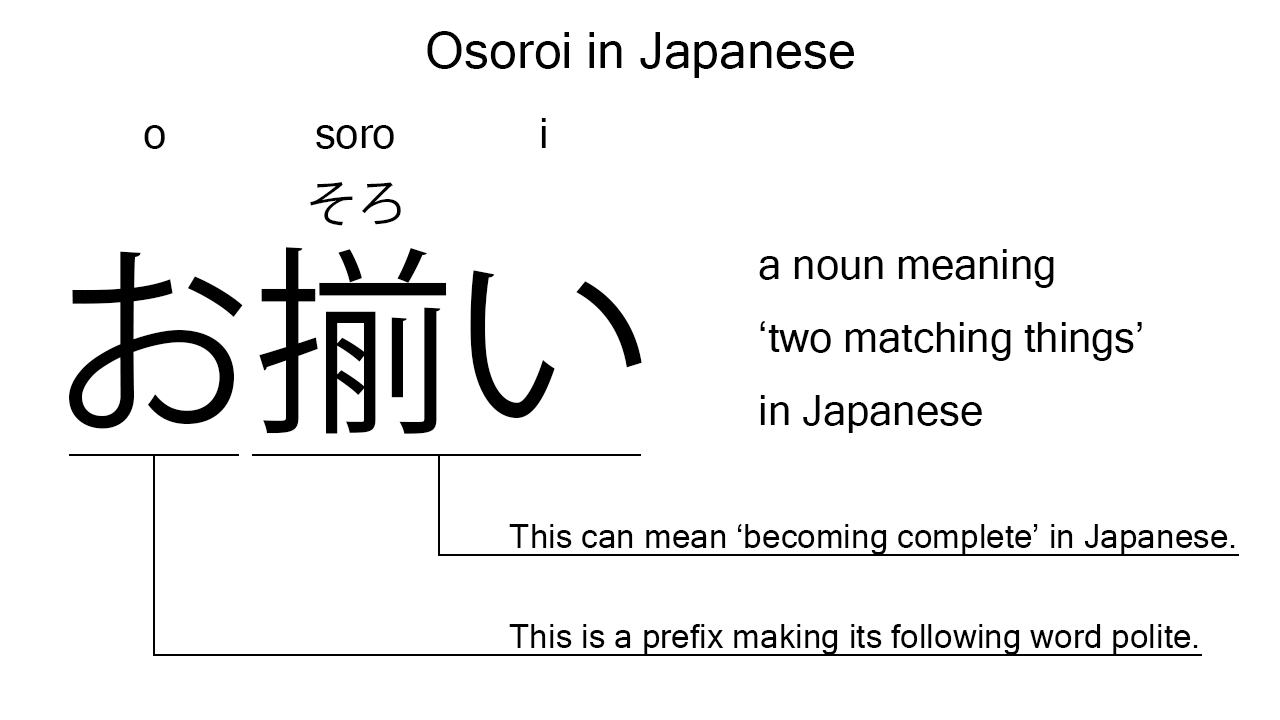What does “osoroi” mean in Japanese?
Native speakers say “osoroi” often to mean “two matching things” in Japanese. Perhaps, some Japanese learners know this word as it is sometimes used in Japanese conversations. In this blog post, however, I will explain it in detail based on its grammatical components. And also, I will explain how to use it through example sentences. My explanations would help Japanese learners understand “osoroi” more clearly. Then, let’s get started!
Contents
Definition and meaning of “osoroi”
Let me start with the definition and meaning of “osoroi”.
- osoroi – お揃い (おそろい) : a noun meaning ‘two matching things’ in Japanese.
Japanese native speakers use this noun often to refer to two matching things. In addition, they sometimes use this like an adjective to mean just ‘matching’.
The definition and meaning are not that difficult, I think. To understand this noun more clearly, however, let me explain its grammatical components in detail, one by one.
What does “osoroi” literally mean in Japanese?
“Osoroi” consists of the following two components:
- o – お : a prefix making its following word polite.
- soroi – 揃い (そろい) : can be considered as the noun form of the verb, “sorou”, which means ‘to become complete’ in Japanese.
From these two components, we can understand that the formed noun is literally the polite expression for becoming complete. This literal interpretation is not completely in line with the actual meaning, but still very close, I think. Being matching can often be considered as having become complete.

When we meet new Japanese words, we should check their grammatical components in detail to understand their meanings clearly and deeply. In many cases, components tell us a lot about the meanings of the words they form. Actually, here, we could get the better understanding of “osoroi” through the detailed check above.
So far, I’ve explained the definition and meaning of “osoroi” together with its grammatical components. Then, let me explain how to use it through the example sentences below.
Example #1: how to say “matching” in Japanese
watashi tachi no fuku wa osoroi desu – 私達の服はお揃いです (わたしたちのふくはおそろいです)
Our clothes are matching.
Below are the new words used in the example sentence.
- watashi – 私 (わたし) : a pronoun meaning ‘I’ in Japanese.
- tachi – 達 (たち) : a suffix used after a noun or pronoun to make its plural form. In the example, this is used after “watashi” to make its plural form, “watashi tachi”, which means ‘we’ in Japanese. Learn more about Japanese plural.
- no – の : a case particle used after a noun or pronoun to make its possessive case. In the example, this is used after “watashi tachi” to make its possessive case, “watashi tachi no”, which means ‘our’ in Japanese.
- fuku – 服 (ふく) : a noun meaning ‘clothes’ in Japanese.
- wa – は : a binding particle working as a case marker or topic marker. In the example, this works after “watashi tachi no fuku” to make the subject in the sentence.
- desu – です : an auxiliary verb used after a noun or adjective to make it polite. Probably, this is well known as a part of Japanese desu form. In the example, this is used after “osoroi” to make it sound polite.
This is a typical usage of “osoroi”. In this example, it works like an adjective to mean ‘matching’ in Japanese.
Example #2: another usage of “osoroi”
kanojo wa osoroi no fuku ga suki desu – 彼女はお揃いの服が好きです (かのじょはおそろいのふくがすきです)
She loves matching clothes.
Below are the new words used in the example sentence.
- kanojo – 彼女 (かのじょ) : a pronoun meaning ‘she’ in Japanese.
- no – の : a case particle joining two nouns. Normally, the first one can work as a modifier to describe the second. In the example, this works to join “osoroi” and “fuku”. The formed phrase literally means ‘matching clothes’ in Japanese.
- ga – が : a case particle used to make the subject word or the object word in a sentence. In the example, this is used after “osoroi no fuku” to make the object in the sentence.
- suki – 好き (すき) : the stem part of the na-adjective, “sukina”, which means ‘favorite’ in Japanese. Native speakers, however, often use this like an individual word to mean ‘to like’ or ‘to love’ in Japanese. In the example, this is used to mean ‘to love’.
This is another typical usage of “osoroi”. In this example, it works together with “no” and “fuku” to mean ‘matching clothes’ in Japanese. Anyway, when we want to refer to two matching things or to describe them in Japanese, “osoroi” is always a very good option.
Summary
In this blog post, I’ve explained the definition and meaning of “osoroi” in detail based on its grammatical components. And also, I’ve explained how to use it through the example sentences. Let me summarize them as follows.
- osoroi – お揃い (おそろい) : a noun meaning ‘two matching things’ in Japanese. This noun is literally the polite expression for becoming complete. This literal interpretation is not completely in line with the actual meaning, but still very close, I think. Being matching can often be considered as having become complete. Japanese native speakers use this noun often to refer to two matching things. In addition, they sometimes use this like an adjective to mean just ‘matching’.
Hope my explanations are understandable and helpful for Japanese learners.
Leave a Reply